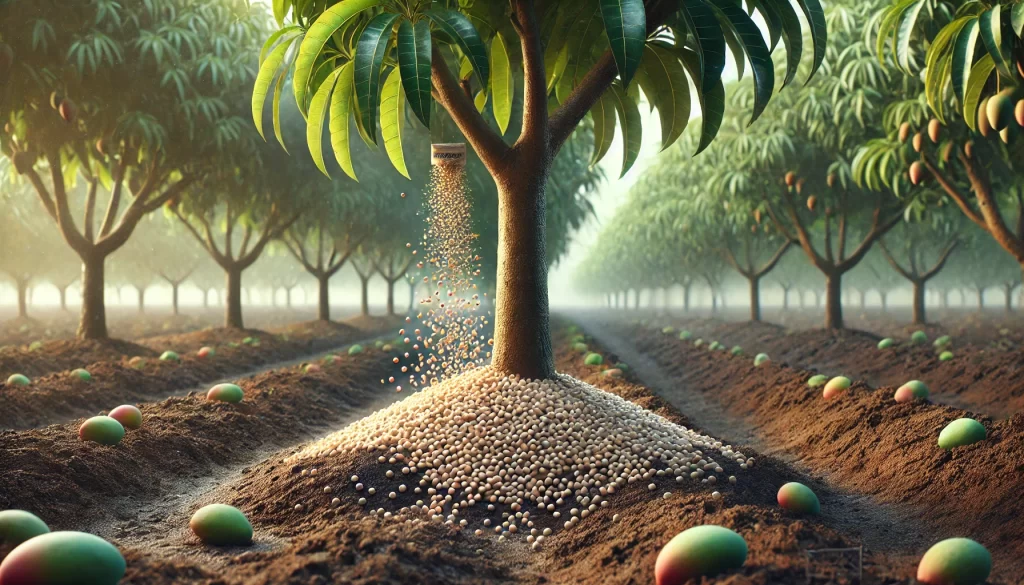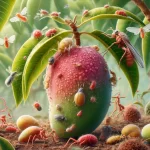Importance of Nutrition in Ataulfo Mango
Proper nutrition is essential for the healthy development of Ataulfo mango and for achieving optimal production of high-quality fruits. Adequate fertilization management ensures that the plants receive the necessary nutrients in the correct amounts and at the right time. This is crucial to promote good vegetative growth, abundant flowering, proper fruit development, and greater resistance to pests and diseases.

Nutritional Requirements of Ataulfo Mango
Macronutrients
Macronutrients are required in large quantities for the growth and development of mango. The main macronutrients are:
- Nitrogen (N): It is essential for vegetative growth and leaf formation. Adequate nitrogen supply promotes vigorous branch growth and the formation of new shoots, which is essential for future fruit production.
- Phosphorus (P): It plays a crucial role in root development, flowering, and fruit ripening. Phosphorus is essential during the early stages of fruit formation as it influences seed development and fruit quality.
- Potassium (K): It is vital for fruit quality, improving the size, color, and sugar content of the fruits. Additionally, potassium increases plant resistance to diseases and helps regulate water within the plant.

Micronutrients
Although micronutrients are needed in smaller amounts, their availability is crucial for the proper functioning of the plant’s physiological processes. The most important micronutrients for Ataulfo mango include:
- Zinc (Zn): It is important for the production of growth hormones and protein synthesis. Zinc deficiency can result in reduced shoot growth and smaller fruit size.
- Boron (B): It is essential for pollination and fruit formation. Boron deficiency can lead to poor fruit set or deformed fruits.
- Iron (Fe): It is crucial for photosynthesis and chlorophyll production. Iron deficiency manifests as chlorosis, especially in young leaves.
Fertilization Plan for Ataulfo Mango

Base Fertilization
Base fertilization is carried out before sprouting and the start of the growth season. This fertilization provides the essential nutrients that the plants need for vigorous initial growth.
- NPK Application: It is recommended to apply a balanced NPK mix (20-20-20) to ensure that the plants have access to all the necessary macronutrients from the beginning of the season.
- Dosage: The specific dosage depends on prior soil analysis and the specific needs of the orchard, but generally, 1 to 2 kg of NPK fertilizer per tree is applied, distributed evenly around the root area.
Top-Dressing Fertilization
Top-dressing fertilization is carried out during the growth cycle and fruit formation. This phase is critical to ensuring good fruit quality and an abundant harvest.
- Nitrogen (N): An additional application of nitrogen can be made to support branch and leaf growth during the season. This can be in the form of urea or ammonium sulfate.
- Potassium (K): It is especially important during fruit formation and development. Potassium chloride or potassium sulfate are common potassium sources that can be applied.
- Phosphorus (P): Although phosphorus needs are lower during the vegetative growth phase, it is important to maintain an adequate supply to support root development and fruit quality.

Foliar Fertilization
Foliar fertilization is used to correct specific micronutrient deficiencies and to provide a nutritional boost during critical stages of the growth cycle.
- Zinc and Boron Applications: Foliar applications of zinc and boron are recommended during the flowering and fruit setting phases to improve pollination and initial fruit development.
- Dosage: The specific dosages vary depending on the product used, but generally, concentrations of 0.5% to 1% for zinc and 0.2% to 0.3% for boron are applied.

Fertilization Strategies Based on the Tree’s Life Cycle
Young Trees (0-3 years)
During the first years, the focus of fertilization should be on root system development and the formation of a strong and well-structured tree. It is recommended:
- Balanced Fertilization: Regular applications of NPK fertilizers to promote vigorous vegetative growth.
- Micronutrients: Foliar applications of zinc and iron to prevent deficiencies and ensure healthy development.
Trees in Production (4 years and older)
For trees in production, the focus shifts to optimizing the quality and quantity of fruits. It is recommended:
- Increased Potassium (K): Increase potassium applications during the fruit development phase to improve size, flavor, and quality.
- Nitrogen Management (N): Adjust nitrogen applications to avoid excessive foliage growth at the expense of fruit production.
- Phosphorus Applications (P): Especially before flowering to improve fruit set.

Monitoring and Adjusting Fertilization
Continuous monitoring of tree health and soil and foliar analysis is essential to adjust the fertilization strategy according to the specific needs of the plants. This includes:
- Soil Analysis: Conduct annual soil analysis to adjust fertilizer applications based on current soil conditions.
- Foliar Analysis: Conduct foliar analysis during the growing season to detect nutrient deficiencies and correct them promptly with foliar applications.
Additional Considerations
- Soil pH Management: Maintaining soil pH within the optimal range (5.5-7.5) is crucial to ensure that nutrients are available to the plants. If soil pH is outside this range, amendments such as lime or sulfur should be applied.
- Organic Fertilization: In some cases, organic fertilizers such as compost or well-decomposed manure can be used, which not only provide nutrients but also improve soil structure and moisture retention.
 AgronoBlog – Agriculture Blog
AgronoBlog – Agriculture Blog 


